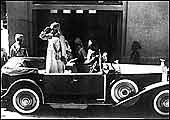|
|
|
The Nizam's Standard Coventry: Nizam
Mahbub Ali of Hyderabad was one of the early royal patrons
|
|
BACK
OF THE BOOK
|
It's
a rare coffee table book that arouses the need for a magnifying
glass. This one, with some 485 images of royal grandeur, old documents
and even ads, does just that-even if you're not a great one for
the finer differences between a steam-powered 'horseless carriage'
and a petrol-combustion motor car. Evidently, it's the second noun
in the title that Sharada Dwivedi, an expert on Indian royalty,
and Manvendra Singh Barwani, a vintage car restorer, are hoping
to hook readers by.
They succeed. With automobiles taking over
from those enormously bedecked elephants of yore (as generators-in-chief
of awe in the adulatory hordes), and from those heavily bejeweled
palanquins (as conveyers of sequestered feminine grace), how else
could it be?
|
|
|
The Automobiles Of The Maharajas
By Sharada Dwivedi And
Manvendra Singh Barwani
Eminence Designs
Price: Rs 3,000
PP: 324
|
The motor car made its first passage to India,
however, as a company vehicle for an Englishman called Forster working
at Greaves Cotton & Co, in 1898. Jamsetji Tata and Ranjitsinhji
were the earliest Indian adopters of the resplendent new technology.
Indian Royalty-the dozens of Princely States slotted by the British
Crown by the count of their respective 'gun salutes'-grew enamoured
of it only after the 1905-06 visit to India by Prince George, for
which Argyll Motors shipped several of its cars to the subcontinent.
By 1911, for the same guy's Coronation Durbar in Delhi as India's
Emperor, the Empire had to deploy a fleet of Rolls-Royces to project
the glory worthy of a man boasting divine investment. This luxury
brand's eagle mascot had already come to stand for "the superlative"
by then, you see-ever since Maharaja Madhavrao Scindia of Gwalior
brought in the first, a Silver Ghost, in 1908, and the Maharaja
of Nabha had his officially named 'Taj Mahal'. By 1947, India's
streets were haunted by some 800 proud Rolls-Royces.
 |
| A Turner Miesse steam car: A version
of the once-well-known Belgian 'Miesse' steam car, the car wowed
onlookers in more ways than one |
 |
| Maharaja of Bikaner's Rolls-Royce Phantom
II: Maharaja Ganga Singh takes the salute at his princely
state's Golden Jubilee celebrations in 1937 |
 |
| A De Dion from the stables of the royal family
of Cooch Behar: Princes Rajendra Narayan and Jitendra Narayan
in their De Dion in 1902-04 |
Don't miss the royal anecdotes that punctuate
the text. The traffic jams caused by the Nizam of Hyderabad, with
swarms of poor compensation seekers hoping to have aged relatives
run over by his car.
The trauma caused to poor old bullocks, hard-pressed
to adapt their notions of traffic negotiation to the motor age.
"The buffalo waits until he sees which side you're going to
take, and then calmly takes the same," records an English diarist
accompanying Maharaja Sayajirao Gaekwad of Baroda on a 'car tour'
to Khandala.
And, of course, the battle to have women accorded
the privilege of travelling in open-top convertibles. It took an
emancipated Gayatri Devi of Cooch Behar marrying Maharaja Jai Man
Singh of Jaipur to have the Rajputana states cast off the oppressive
old 'purdah'.
The first to develop a fetish for fast cars-not
that torque, balanced handling, safety and so on were selling points
in those benighted times-was Maharaja Bhupinder Singh of Patiala,
whose acquisition of a '12-zeppelin-engine' Maybach in 1935 set
tongues wagging.
The book, ironically, is sponsored by Hyundai,
which hit the Indian tarmac with the Santro-a favourite of Doors-raving
'roadhouse' yuppies-a whole century after the first automobile rolled
its rubber here. It has been one helluva century, really. It's 2004
now, and the Prime Minister's deputy has finally called for a 'people's
car': (priced under Rs 1 lakh). It'll still be a box on four wheels,
though. Plus ca change...
|
